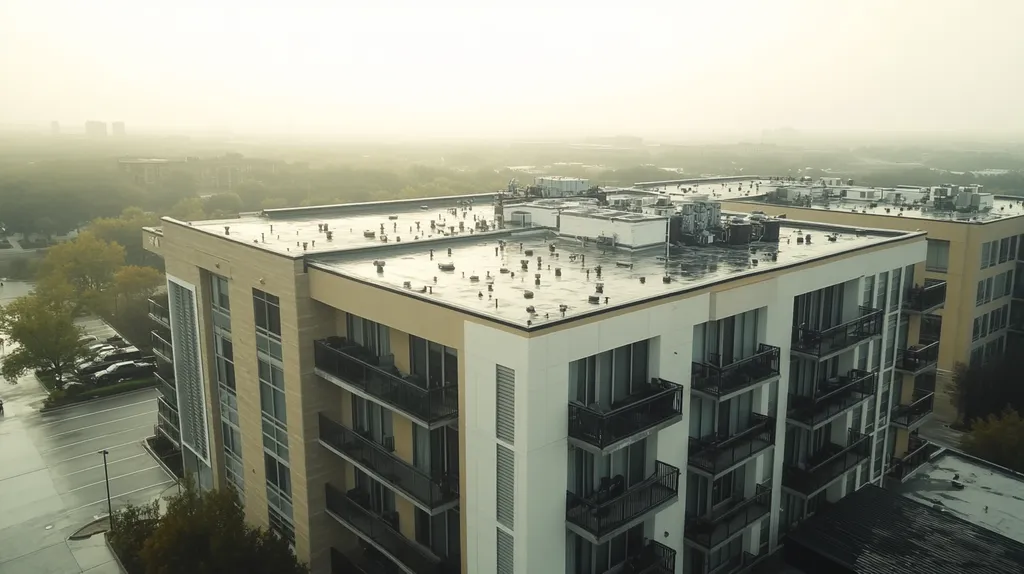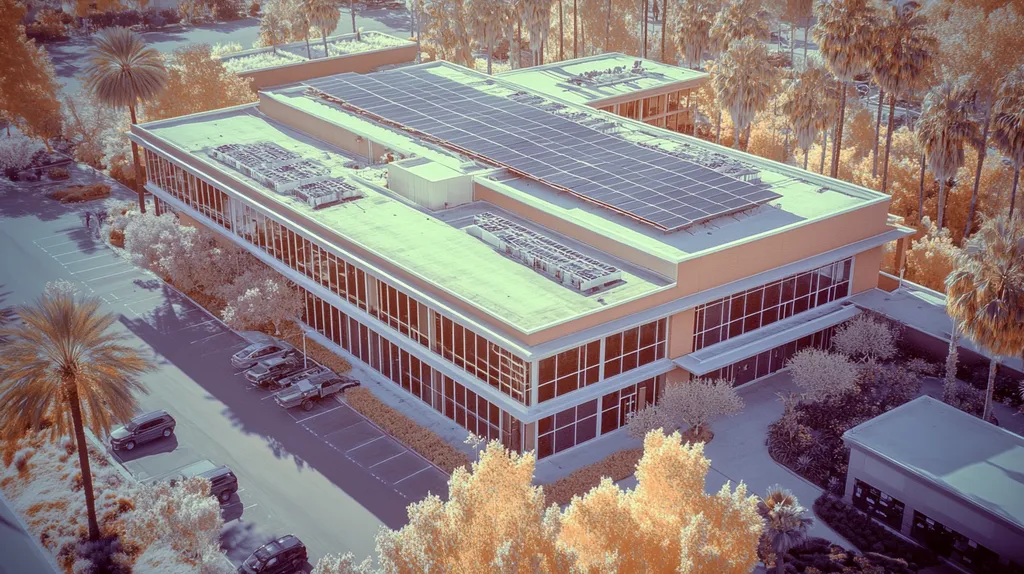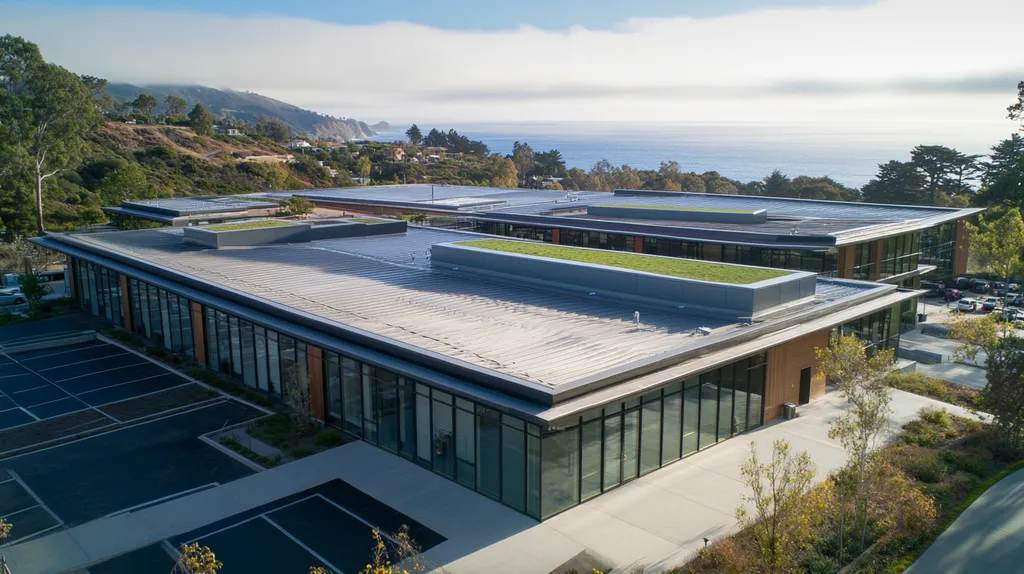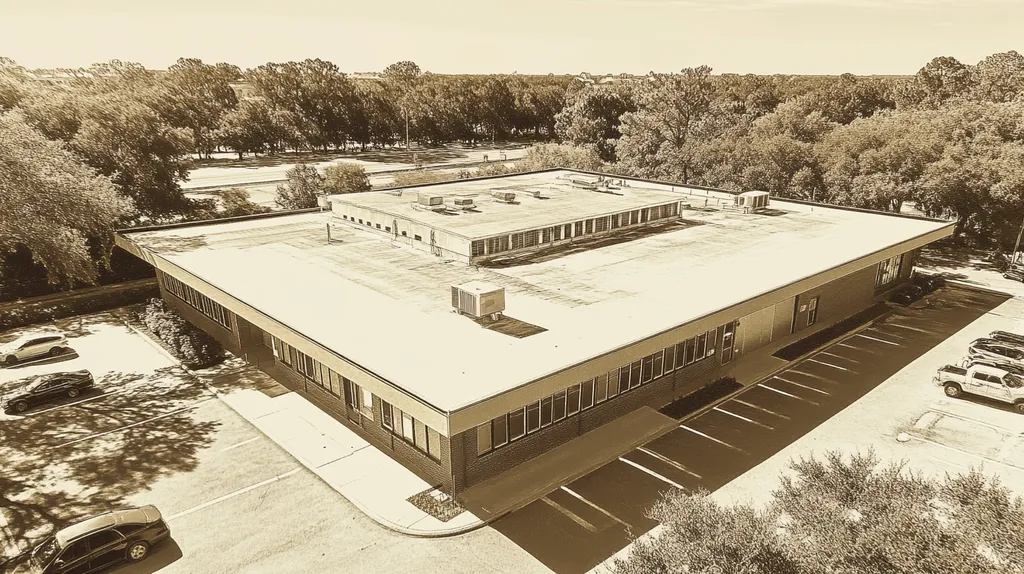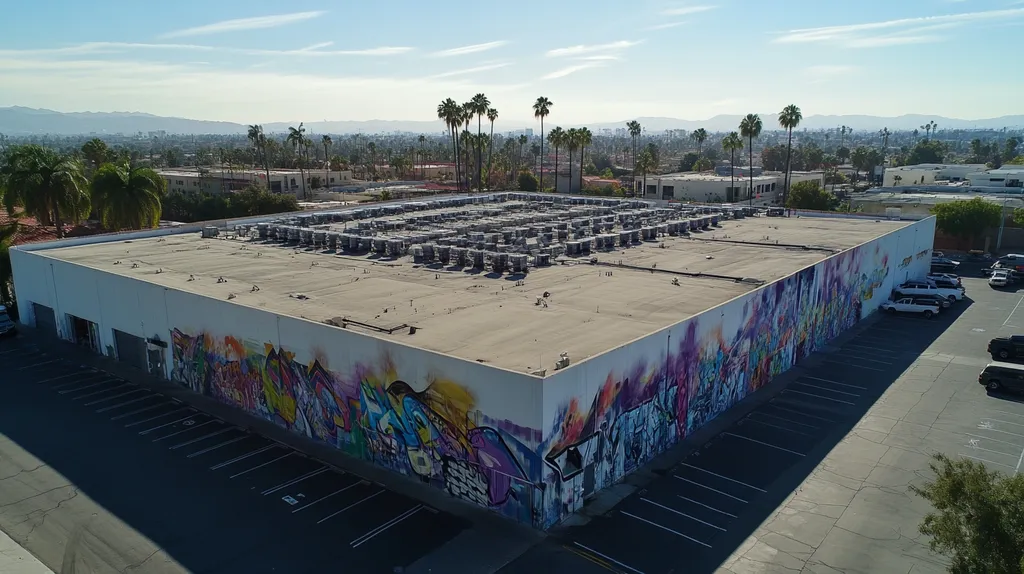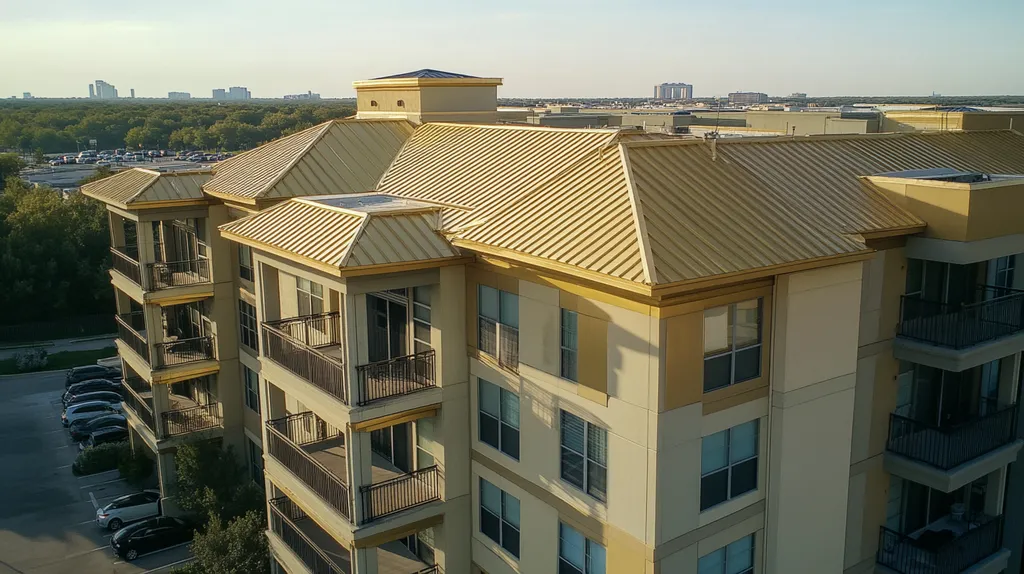Commercial roofing failures cost U.S. businesses over $2.5 billion annually in repairs, with 80% of these expenses directly linked to inadequate maintenance. For many facilities, the roof represents up to 15% of the total building investment.
Yet studies show that implementing a structured preventive maintenance program can extend a roof’s lifespan by 50% while reducing lifetime costs by up to 60%.
This comprehensive guide provides facility managers with essential strategies for protecting their roofing investments through systematic inspection protocols, financial planning, compliance measures, and risk management techniques.
SECTION 1: PERFORMANCE FACTORS
In the world of commercial roofing, overlooking small issues can have a big financial impact. Roofs can represent as much as 15% of a building’s total value, making it essential for property owners and facility managers to understand the factors that threaten roof integrity. By identifying damage, assessing drainage performance, and evaluating terminations, they can effectively protect this critical asset. Taking these preventive maintenance steps can save thousands in repairs and extend the lifespan of the roof.
Identifying Roof Surface and Membrane Damage
Regular inspections are essential for spotting surface and membrane damage on commercial roofs. Issues like cracks, blisters, and punctures can allow water to seep in, jeopardizing the entire roofing system. Detecting these problems early can prevent costly leaks and mold growth.
Facility managers should closely examine the roofing membrane, which is the first barrier against the elements. Signs of discoloration and tears often signify deeper issues that need immediate attention. Utilizing infrared scanning technology can help identify hidden moisture within the roof structure.
Conduct visual inspections at least twice a year and after severe weather events. This proactive stance ensures that minor issues do not develop into more significant and expensive repairs. Maintaining a detailed log of inspections aids in tracking changes and planning future actions.
Reinforcing seams and flashing areas is critical, as these junctions are particularly vulnerable to damage. Regular monitoring can significantly lengthen the lifespan of the roofing membrane.
Key Action Items
Assessing Drainage Efficiency and Ponding Water
Poor drainage can severely compromise a commercial roof’s longevity. Water pooling on the surface can lead to premature failure and structural issues. Accordingly, identifying areas where water tends to collect is vital for risk management.
Facility managers must regularly check gutters, downspouts, and drains for blockages. Clogged systems can intensify ponding, exerting undue stress on roofing materials. A well-maintained drainage system is crucial for the roof’s integrity.
In addition to routine inspections, consider implementing upgrades to boost drainage efficiency. Adding scuppers or modifying slope designs may be necessary for areas with poor drainage. Such adjustments can prevent future pooling and help extend the roof’s lifespan.
Educating staff about the importance of maintaining drainage systems is equally essential. Simple actions, like cleaning gutters and checking drains, can greatly enhance roof performance.
Key Action Items
Evaluating Roof Terminations and Edge Integrity
The terminations and edges of a roof are often its most exposed areas, making them particularly vulnerable to weather-related damage. Wind, water, and debris can threaten these critical points, leading to leaks and structural concerns. Regular assessments of edge conditions are vital for sustaining roof health.
Inspect flashings, seals, and terminations for signs of wear or damage. Ensure that seams are secure and check for any gaps that might permit water entry. Prompt repairs at these vulnerable points can prevent significant damage to the roofing assembly.
Additionally, consider how rooftop equipment and accessories affect edge integrity. Vents and HVAC units must be properly installed and sealed to maintain the roof’s performance. Regularly check these installations for secure fastening and adequate sealant.
Lastly, establishing a maintenance schedule for edge inspections will enable timely repairs before they escalate into more serious issues. Investing time in these evaluations can yield significant savings and better protect the roofing investment.
Key Action Items
SECTION 2: FINANCIAL CONSIDERATIONS
Investing in a commercial roof involves significant financial commitment, but failing to maintain it can lead to skyrocketing costs. Properties that ignore routine upkeep may face dire consequences, including severe water damage, structural problems, and escalating repair bills. Research indicates that costs for deferred maintenance can far exceed the price of regular inspections and timely repairs. For facility managers, understanding the financial impact of roofing decisions is vital for protecting their substantial investments.
Cost Impacts of Deferred Roof Maintenance
Neglecting roof maintenance triggers a cycle of rising expenses. Small issues, when left unaddressed, can escalate into major complications that necessitate costly repairs or even complete roof replacements. For instance, a repair for a minor leak could cost a few hundred dollars, while neglect may lead to thousands in structural remediation.
This financial strain can ripple through facility budgets, jeopardizing operational efficiency and cash flow. A roof failure can force a business to shut down temporarily, resulting in lost revenue. Facilities that prioritize maintenance can break this cycle and keep costs in check.
Beyond direct repair costs, indirect expenses also mount. Increased energy bills can occur from poorly insulated roofs that allow temperature fluctuations. By ignoring maintenance, facilities risk not only their physical integrity but their overall financial health.
Key Action Items
Budgeting for Routine Inspections and Minor Repairs
A well-planned budget for regular roof inspections and minor repairs is crucial for effective facility management. These routine check-ups enable facility managers to pinpoint weaknesses before they become substantial issues, ideally scheduling inspections at least twice a year or following severe weather incidents.
Allocating a reasonable budget for inspections can lead to considerable savings over time. Inspection costs generally range from $200 to $500, a fraction compared to the price of a full roof replacement, which can soar to between $20,000 and over $100,000, depending on various factors.
Additionally, budgeting for minor repairs ensures proactive responses to identified concerns, actively preventing them from spiraling into crises. An emergency repair fund also helps mitigate downtime when unforeseen problems arise.
Key Action Items
Calculating Return on Investment from Preventive Maintenance
Understanding the return on investment (ROI) of preventive maintenance is essential for justifying costs to stakeholders. By documenting maintenance expenses alongside savings from avoided damage repairs, facility managers can illustrate clear financial advantages. For example, investing $1,000 annually in maintenance could prevent a $20,000 repair, yielding an impressive 20:1 ROI.
Moreover, the benefits of maintenance extend beyond immediate savings. A properly maintained roof can last significantly longer, reducing the frequency and necessity of replacements. Extending a roof’s lifespan from 20 years to 30 years through consistent care represents substantial cost savings.
Facility managers can leverage software tools to track maintenance activities and spending, facilitating detailed assessments of budget versus actuals. This data not only aids budget requests but also fosters transparency in financial decision-making.
Key Action Items
SECTION 3: COMPLIANCE REQUIREMENTS
Adhering to compliance regulations is crucial for maintaining the integrity and safety of commercial roofs. Ignoring local building and fire codes can lead to substantial financial penalties and compromise safety. Alarmingly, around 30% of roofing failures can be attributed to non-compliance issues, emphasizing the need for facility managers to stay informed about the necessary requirements. This section highlights the importance of understanding local codes, aligning with warranty guides, and committing to environmental standards.
Understanding Local Building and Fire Codes
Local building and fire codes exist to ensure the safety and reliability of structures. Each jurisdiction has unique regulations outlining the materials and construction methods permissible for roofing systems. Non-compliance can result in fines and potential liability issues for facility managers.
Using non-compliant roofing materials could invalidate insurance claims during incidents like fires or hailstorms, underscoring the importance of remaining informed about local regulations that may change annually. Regularly reviewing local codes with roofing professionals can also help mitigate risks associated with non-compliance.
By investing in compliance measures, facilities not only enhance safety but can also increase their property value. Compliant buildings are often more attractive to tenants and buyers looking for secure, reliable spaces.
Key Action Items
Ensuring Compliance with Warranty and Manufacturer Guidelines
Warranties are vital for protecting roofing investments, but they come with specific compliance requirements that must be adhered to. Manufacturers typically outline maintenance schedules and installation methods in their guidelines, and failure to follow these can void warranty coverage.
Facility managers should keep meticulous records of maintenance and repairs to demonstrate warranty compliance. For example, missing scheduled bi-annual inspections could result in loss of warranty benefits, leading to unprecedented financial consequences in the case of a roofing failure.
Collaboration with knowledgeable roofing contractors is essential to ensure all installations meet manufacturer specifications. Regular communication with manufacturers can also yield updates on best practices and changes in warranty terms, ultimately protecting the facility against unexpected costs.
Key Action Items
Meeting Environmental and Energy Efficiency Standards
As environmental and energy efficiency standards gain importance in the roofing sector, compliance becomes increasingly beneficial. Adhering to these standards not only promotes sustainability but can also yield cost savings through reduced energy consumption. Facilities meeting these criteria might also qualify for tax incentives or rebates.
For instance, cool roofing technologies can lower cooling costs by as much as 20% in moderate to large commercial buildings. To remain compliant, facility managers must keep abreast of local, state, and federal energy policies.
Implementing environmentally friendly practices can enhance a facility’s reputation. As eco-conscious tenants and consumers seek sustainable properties, regular audits can help pinpoint areas for improvement. Investing in compliant roofing solutions positions a property favorably in a competitive market.
Key Action Items
SECTION 4: RISK MANAGEMENT
The integrity of a commercial roof is crucial for the overall health of any facility. Water infiltration can lead to significant structural issues, resulting in expensive repairs and operational disruptions. Alarmingly, 80% of roofing failures stem from poor maintenance practices. Therefore, facility managers must prioritize risk management strategies to ensure their roofs remain a sound investment. This section outlines key areas: detecting water infiltration, managing material deterioration, and establishing safety protocols for roof access.
Detecting and Mitigating Water Infiltration Risks
Water infiltration is a primary cause of damage to commercial roofs, with even minor leaks potentially escalating into major structural problems if not addressed. Regular inspections should target known vulnerabilities, particularly seams and flashing, utilizing moisture detection technology to uncover hidden leaks before they become apparent.
Implementing a systematic approach to maintain drains and gutters is critical. Clogged drainage systems can lead to water pooling on the roof, significantly increasing leak risks. Regular cleaning and inspection, especially during seasonal changes, can greatly reduce this threat.
Moreover, investing in high-quality roofing materials designed to resist UV light and moisture will enhance durability. Property managers should consult with roofing professionals to evaluate the best options for their specific environments. Lastly, establishing a clear response plan for inspection findings ensures that team members are prepared to report and address vulnerabilities quickly.
Key Action Items
Managing Structural and Material Deterioration Hazards
All roofing materials degrade over time due to weather exposure and physical stress. Conducting regular assessments of membrane condition, insulation integrity, and structural components is necessary for catching deterioration early. A simple visual inspection can often highlight cracks or blisters in roofing materials.
It is equally important to recognize environmental factors impacting the roof. In high-traffic areas, foot traffic can accelerate material wear. Installing walking pads or designated pathways can help minimize this risk and prolong the roof’s lifespan.
Moisture retention and extreme temperatures can also hasten deterioration. Facility managers should consider reflective roofing surfaces to combat heat absorption, potentially leading to energy savings and greater material longevity. Maintaining a detailed log helps track issues over time, ensuring proactive budget allocations for repairs.
Key Action Items
Establishing Roof Access Controls and Safety Protocols
Safety is paramount when accessing commercial roofs for inspections or repairs. Uncontrolled access can lead to accidents or unauthorized activities that may compromise roof integrity. Therefore, companies must implement strict access controls to manage who can access the roof and under what circumstances.
Training maintenance staff on safety procedures and the significance of compliance can prevent accidents. Conducting regular safety drills reinforces these protocols and ensures everyone is familiar with the procedures. Moreover, providing appropriate safety equipment, such as harnesses and helmets, is essential for protecting personnel during maintenance activities.
Establishing visible indicators for safe access points also enhances safety by directing personnel away from vulnerable areas. This proactive approach contributes to preserving the roof’s condition while safeguarding those who work on it.
Key Action Items
SECTION 5: OPERATIONAL PROCEDURES
Facility managers must proactively safeguard their commercial roofing investments. If issues arise unexpectedly, they can result in costly repairs and significant operational downtime. Routine maintenance is proven to extend a roof’s lifespan by up to 50%. This section underscores the necessity of establishing structured operational procedures—regular inspections, thorough documentation, and engagement with professional roofing contractors—ensuring roofs are well-maintained and functional.
Scheduling Regular Roof Inspections and Cleaning
Regular inspections and cleaning are fundamental for identifying potential roofing problems before they worsen. Establish a schedule for biannual inspections to assess the roof’s condition and pinpoint areas of concern. During these evaluations, trained personnel can identify signs of wear, like membrane cracks or water pooling, which could lead to significant issues if left unattended.
Cleaning the roof at least twice a year is critical as well. Accumulated debris can trap moisture and contribute to material deterioration. Removing leaves, dirt, and other obstructions enhances drainage efficiency, thus decreasing the likelihood of leaks and structural damage.
Employing drones or infrared technology can improve inspection efficiency, allowing for detailed assessments with minimal disruption to building operations. By integrating advanced tools with systematic inspection schedules, facility managers can maximize maintenance effectiveness.
Key Action Items
Documenting Maintenance Activities and Condition Reports
Accurate documentation of maintenance activities is vital for effective roof management. Facility managers should keep a comprehensive log that includes inspections, repairs, and professional assessments. This log offers a transparent history of the roof’s condition and serves as a valuable reference for future needs.
Condition reports must detail specific findings, such as observed damage and actions taken in response. This process fosters accountability and allows for tracking performance trends, which aids in timely preventive interventions.
Using digital management systems can enhance documentation, making it easier to share information among relevant stakeholders. This access improves communication and facilitates collective decision-making regarding necessary upgrades or repairs.
Key Action Items
Coordinating with Roofing Contractors for Repairs and Upgrades
Building strong relationships with qualified roofing contractors enhances maintenance efforts. When repairs or upgrades are required, it’s crucial to engage professionals who have a deep understanding of the specific roofing system in place.
Coordination should focus on thorough assessments where contractors evaluate reported issues and recommend solutions or upgrades. Proactive discussions ensure facility managers receive expert advice aligned with long-term roofing strategies.
To promote effective budgeting, facility managers should obtain multiple quotes, helping to identify the best service options available. Sharing previous inspection results with contractors provides valuable context, facilitating more effective repairs.
Key Action Items
SECTION 5: OPERATIONAL PROCEDURES
Facility managers face immense pressure to protect their commercial roofing investments. An unexpected roofing issue can not only lead to substantial repair costs but also disrupt daily operations. Industry reports indicate that regular maintenance can extend a roof’s lifespan by up to 50%. This section highlights the critical need for structured operational procedures involving regular inspections, thorough documentation, and collaboration with qualified roofing professionals.
Scheduling Regular Roof Inspections and Cleaning
Conducting routine inspections and cleaning is essential for early identification of potential roofing issues. Schedule biannual roof inspections to evaluate material condition and spot vulnerable areas. During these assessments, trained personnel can detect signs of wear, such as membrane cracking or areas of pooling water, which could escalate into severe problems if not addressed timely.
Cleaning is equally crucial, with a recommended frequency of at least twice a year. Accumulated debris can trap moisture, contributing to material deterioration. By removing leaves, dirt, and other obstructions, facility managers can enhance drainage efficiency, thereby minimizing the risk of leaks and related structural damage.
Advanced technologies, like drones or infrared cameras, can further enhance inspection efficiency, providing detailed analyses with minimal disruption. Integrating these tools with well-planned inspection schedules maximizes maintenance effectiveness.
Key Action Items
Documenting Maintenance Activities and Condition Reports
Thorough documentation of maintenance activities is vital for effective roof management. Facility managers should maintain a detailed log encompassing inspections, repairs, and professional evaluations. This comprehensive record presents a transparent history of the roof’s condition, serving as a valuable reference for future decisions.
Condition reports must detail specific findings, including any observed damage and actions taken in response. This clarity fosters accountability and assists in monitoring the roof’s performance over time. Regular updates facilitate the identification of recurring issues, enabling managers to implement timely preventive measures.
Utilizing digital management systems can simplify documentation, offering easy access and sharing capabilities among relevant stakeholders. This technological approach enhances communication and supports collaborative decision-making regarding necessary upgrades or repairs.
Key Action Items
Coordinating with Roofing Contractors for Repairs and Upgrades
Building strong relationships with qualified roofing contractors is essential for effective maintenance strategies. When repairs or upgrades are necessary, it is critical to engage experienced professionals familiar with the specific roofing system in place.
Coordination should involve comprehensive assessments, during which contractors evaluate reported issues and recommend appropriate solutions or upgrades. Proactive discussions ensure facility managers receive expert advice that aligns with their long-term roofing plans.
Facility managers should prioritize obtaining multiple quotes to evaluate competitive service options. This practice not only aids in budget planning but also ensures that managers are informed about the best available solutions.
Furthermore, sharing previous inspection results with contractors provides them with valuable context to enhance the effectiveness of repairs. Ongoing communication and collaboration with contractors are vital to maintaining the roof’s integrity and extending its service life.
Key Action Items
The Bottom Line
Commercial roof failures cost U.S. businesses over $2.5 billion annually, with 80% of these expenses directly attributable to inadequate maintenance practices.
Implementing the preventive maintenance steps outlined in this guide can extend a roof’s lifespan by up to 50% while reducing lifetime costs by as much as 60%.
From regular inspections and proper documentation to compliance with building codes and manufacturer guidelines, each element plays a crucial role in protecting this vital asset.
As environmental standards evolve and energy efficiency becomes increasingly important, facility managers must stay informed about emerging technologies and best practices.
The return on investment from preventive maintenance is clear: every dollar spent on routine upkeep can save facility owners $10-$20 in future repairs.
FREQUENTLY ASKED QUESTIONS
Q. What performance factors threaten my commercial roof?
A. Key factors include membrane damage, poor drainage, and edge integrity. Regular inspections can identify these issues early, helping to maintain roof integrity and longevity.
Q. How does deferred maintenance impact my industrial roof finances?
A. Neglecting maintenance can lead to escalating repair costs. Small issues may become major problems, increasing operational downtime and disrupting cash flow due to unexpected expenses.
Q. Why is compliance crucial for my commercial roof?
A. Compliance ensures adherence to local codes, which protects safety and avoids penalties. Regular reviews can help keep your roofing system aligned with updated regulations, enhancing property value.
Q. How can I detect water infiltration in my roof?
A. Regular inspections focusing on seams and flashing are essential. Using moisture detection technology can uncover hidden leaks before they escalate into significant structural issues.
Q. What should I include in my operational procedures for roofing?
A. Include scheduled inspections, thorough documentation of maintenance, and coordination with qualified roofing contractors to ensure robust roof management and timely repairs.
Q. How do I choose the right roofing contractor for my commercial roof?
A. Look for certified and experienced professionals familiar with your roofing system. Obtain multiple quotes and share inspection findings to ensure effective and informed repairs or upgrades.
Q. What are the benefits of reflective roofing materials?
A. Reflective roofing materials help reduce heat absorption, improving energy efficiency and extending the lifespan of the roof. They can lead to lower cooling costs and contribute to overall sustainability.

